Bond Patterns
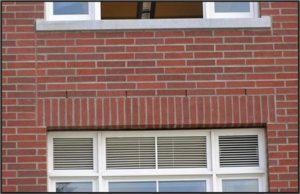
1/3 Running Bond
These Norman size clay brick units have been laid in 1/3 running bond. Note the 1/3 : 2/3 stagger in the head joint spacing.
This is the natural bond pattern for units that are 3 times as long as they are thick. ½ bond patterns are also an option if that appearance is preferred. See Section 1.3.3 for layout information.
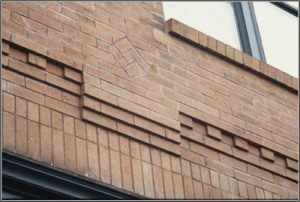
Unit Orientation Effects
This example shows a variety of unit orientations that can be employed to create interesting patterns. The vertical full units are laid as “Soldiers”. The exposed ends of units are laid as “Headers” on the flat, or as “Rowlocks” when they are on edge.
Projecting a course over the one below produces a “Corbel” detail.
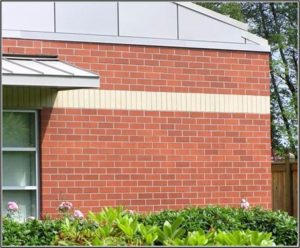
Soldier Course Pattern
This example shows a soldier course pattern of vertically laid units. It has been used as banding detail, in combination with a contrasting colour to provide a horizontal accent to the rest of the field of the wall. For specific information on layout for this unit orientation see Section 2.1.3.
The rest of the wall has been laid in a standard ½ running bond.
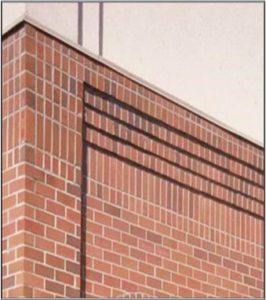
Soldier & Rowlock Patterns
This example shows two unit orientations that can be employed to create interesting patterns. The vertical full units are laid as “Soldiers”. The exposed ends of units are laid as “Rowlock” courses.
These have been laid in five vertically aligned courses to produce a “Stack Pattern” detail. Projecting the courses over the ones below produces a series of “Corbel” details that provide dramatic horizontal shadow affects.
The rest of the wall has been laid in a standard ½ running bond.
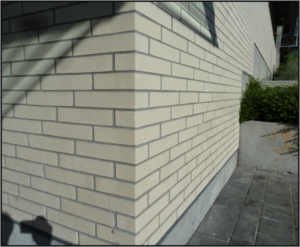
1/3 Running Bond
These Norman size clay brick units have been laid in 1/3 running bond. Note the 1/3 : 2/3 stagger in the head joint spacing.
This is the natural bond pattern for units that are 3 times as long as they are thick. ½ bond patterns are also an option if that appearance is preferred. See Section 1.3.3 for layout information.
https://www.high-endrolex.com/13
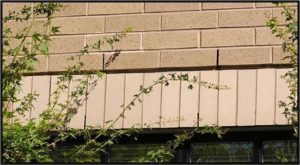
Soldier Course Band
This example shows a soldier course pattern of vertically laid units. In combination with a contrasting colour, it provides a horizontal lintel detail. For specific information on layout for this unit orientation see Section 2.1.3.
The rest of the wall has been laid in 1/3 running bond.
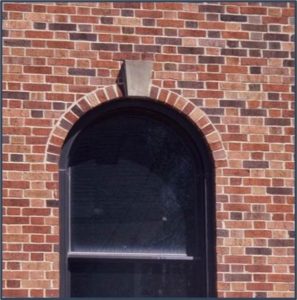
Flemish Bond
This example shows the two unit orientations that can be employed to create a “Flemish Bond” pattern.
The units are laid alternately as regular “Stretchers”, and as “Headers” that appear to be ½ units. In this historical pattern, the headers were turned into the wall to bond multiple layers (wythes) of brick together.
This traditional pattern can be re-created in modern, single-wythe veneers by using ½ bricks to replace the headers.
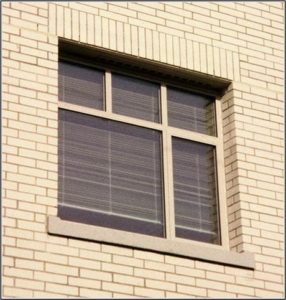
1/3 Bond / Soldier course
These buff coloured Norman size units have been laid in 1/3 bond – note the 1/3 – 2/3 stagger of the head joints.
This is the natural bond pattern for units that are 3 times as long as they are thick. ½ bond patterns are also an option if that appearance is preferred. See Section 1.3.3 for layout information. A modular horizontal layout has been utilized – note the full return units at the recessed jambs. The units in the courses above and below have been cut as “closers” that are 2/3 of a unit length.
The same units have been used as a soldier course in the lintel above the opening. The height of the vertical “soldier” course is equal to the height of four horizonal courses. A precast sill with an upstand at each jamb has also been used. As we recommend, both the lintel and the sill have been extended beyond the jambs, which provides a natural bearing appearance.
The steel angle lintel support has been extended into the wall on either side to provide a shelf angle to form a horizontal movement joint.
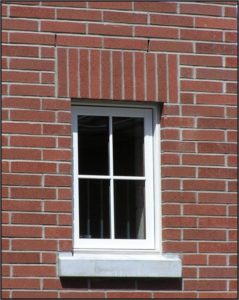
1/3 Bond / Soldier Course
These red Norman size units have been laid in 1/3 bond – note the 1/3 – 2/3 stagger of the head joints.
This is the natural bond pattern for units that are 3 times as long as they are thick. ½ bond patterns are also an option if that appearance is preferred. See Section 1.3.3 for layout information. A modular horizontal layout has been utilized – note the full return units at the recessed jambs. The units in the courses above and below have been cut as “closers” that are 2/3 of a unit length.
The same units have been used as a soldier course in the lintel above the opening. The height of the vertical soldier course is equal to the height of four horizonal courses. A precast sill with an upstand at each jamb has also been used. As we recommend, both he lintel and the sill have been extended beyond the jambs, which provides a natural bearing appearance.
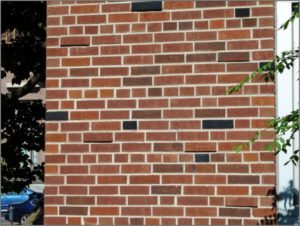
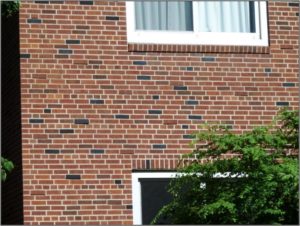
Common Bond / Staggered Head Joints
This dramatic wall effect is based on a “Common Bond” pattern, which was frequently used in historic loadbearing brick masonry. In this pattern, a row of headers occurs every five or six courses. In historic masonry, these were full units that were turned into the wall to bond multiple layers (wythes) of brick together. In this case, a modern single wythe veneer reflects this historic pattern.
In this unusual example, the units in the rest of the courses have been laid in ¼ bond, with occasional dark coloured units mixed in. Yet another detail has been used – a few of the regular “stretcher” units protrude slightly, which provides a subtle shadow effect.
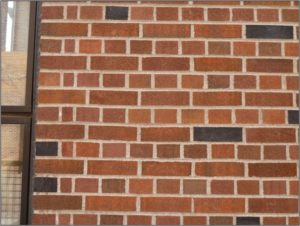
English Bond
This is an example of a pattern in which the courses alternate between regular “stretcher” units and “header” that appear to be ½ units. In historic masonry, the headers were full units that were turned into the wall to bond multiple layers (wythes) of brick together. In this case, a modern single wythe veneer reflects this historic pattern. Note the ¼ length “closer” units that have been used at the jamb to maintain a full ½ unit for the return.
For this project, occasional units in a contrasting accent colour have also been included.
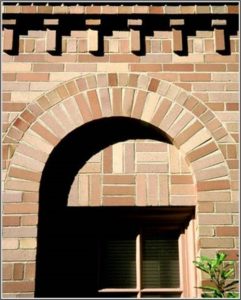
Basket Weave Pattern
This beautiful detail employs a “basket weave” pattern as an inset under the “soldier”/”rowlock” arch. These are modular units, where the unit length in the vertical “soldier” course equals the height of three horizontal courses.
This application also uses a strong bracket detail above the arch.